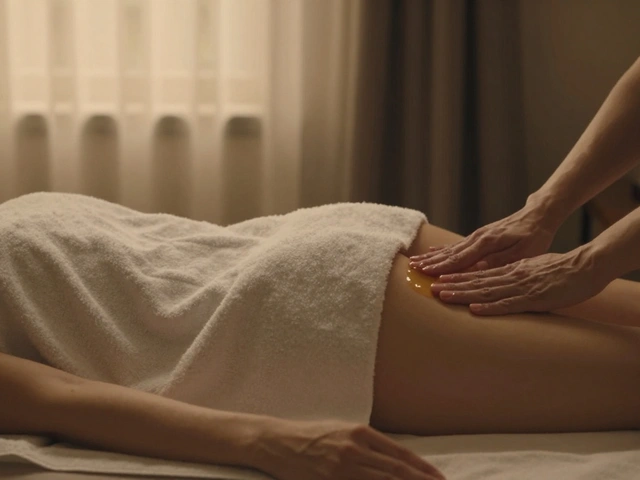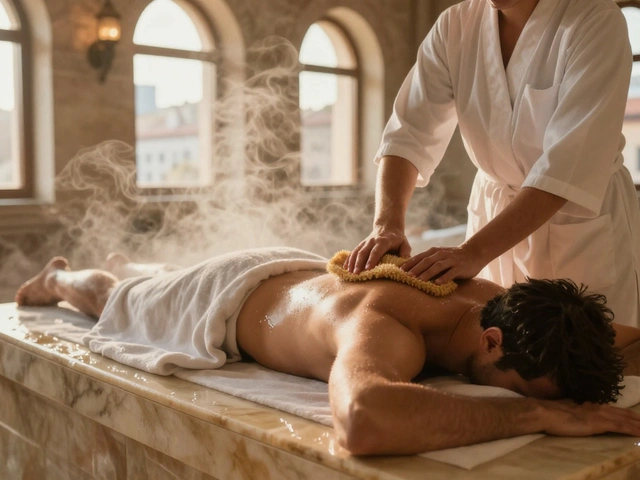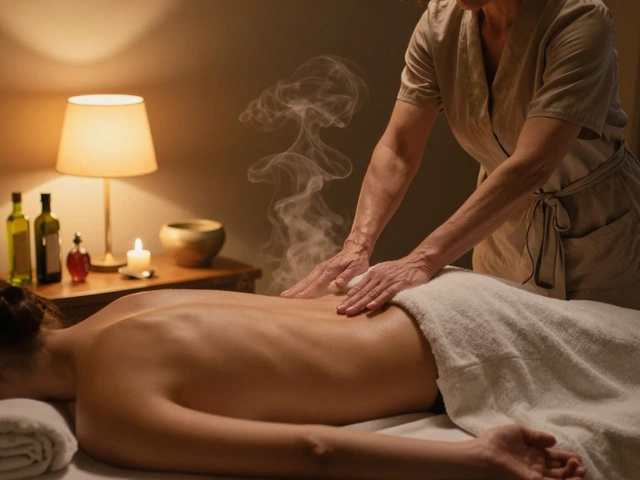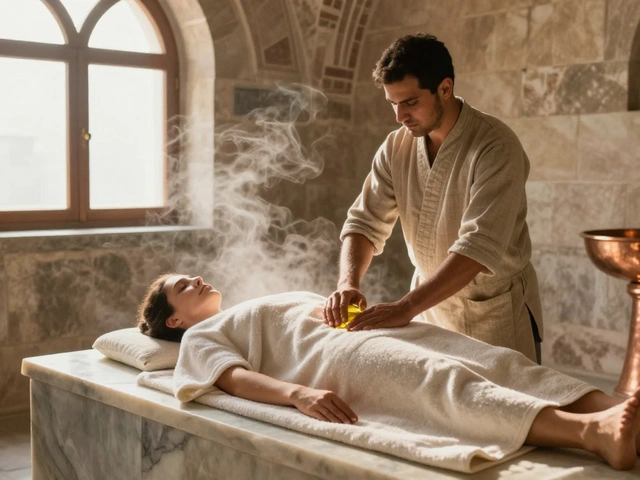Think you know relaxation? Istanbul is rolling out the red carpet for Thai massage, and trust me, it’s nothing like your standard spa rubdown. Picture this: the ancient Thai healing art fusing with the city’s electric energy, offering something so deeply rejuvenating it's almost rebellious. Word on the street is, stressed-out Istanbulites—locals, expats, and tourists racing through Grand Bazaar’s chaos—are lining up for the mind-melting stretches and swift pressure points only Thai therapists can deliver. People are swapping their after-work coffees for an hour on the mat, letting centuries-old techniques push their reset button. Ever had your back walked on, yoga style, by someone who smiles the whole time? It’s equal parts therapy and adventure, and Istanbul has gone all in.
Key Points
- Thai massage is now must-try in Istanbul, bringing together ancient eastern techniques and the city’s buzzing vibe.
- Sessions combine stretching, deep pressure, and rhythmic rocking—nothing passive or boring here.
- You’ll find a wide range of options, from boutique spas near Taksim Square to hidden spots in Kadıköy.
- Expect clear upfront pricing, English-speaking therapists, and strong safety standards across reputable locations.
- Benefits go beyond relaxation: improved flexibility, real stress relief, tension release, and sometimes serious back-popping satisfaction.
Direct Answer
Looking for the best Thai massage Istanbul experience? You’ll find signature services led by certified Thai therapists all over the city, especially in areas like Şişli, Beşiktaş, and Kadıköy. Typical sessions blend yoga-like stretching, acupressure, and deep tissue work on a floor mat. This isn’t your average oil massage. Prices range from 800-1800 TRY per hour at reputable spas and you can usually book online. Just show up in comfy clothes, leave your worries—and your shoes—at the door, and let the therapy begin.
Comprehensive Guide to Thai Massage in Istanbul
Living in Istanbul comes with perks: coffee that packs a punch, kebabs on every corner, Instagram-worthy sunsets over the Bosphorus. But it also means traffic jams that can turn your brain to mush and to-do lists that never end. When my son Julian started school and I somehow landed more meetings than ever, my back cried out for mercy. Here’s where Thai massage enters as a genuine lifesaver. Unlike the sleepy traditional oil massages, Thai massage throws you right into a blend of yoga, bodywork, and deep stretching, guided by a therapist who knows exactly how to coax knots from your muscles.
This isn’t trendy wellness fluff. The origins date back more than 2,500 years to Buddhist monks in Thailand, blending principles of Ayurveda and Chinese medicine. They believe it gets your “sen” energy lines humming—and nothing feels quite like the mix of stretching and gentle pressure they bring. Istanbul, plugged into all things global and ancient, has adapted this art with a flavor all its own. You’re just as likely to spot a yoga-loving local as a jet-lagged tourist getting their first taste in a plush Levent hotel or a cozy spa tucked near the Bosphorus.
Istanbul’s multicultural flair means some spas here offer fusion treatments—Turkish hammam meets Thai stretching? That’s a thing, and it’s glorious. More interesting: Many therapists are from Thailand or have trained there, so they’re the real deal. A few joints have murals of Wat Pho or incense-filled lobbies, giving off vacation-in-Bangkok vibes. Need a fun fact? Turkey’s Ministry of Health requires even international massage therapists to get certified locally, so licensed therapists really do have their credentials.
Ever heard someone say a massage “hurts so good”? Thai massage is that in a nutshell. Expect therapists to use everything—their hands, elbows, knees, and sometimes feet! It sounds wild, but it’s actually structured and safe. They work through muscle groups with a blend of rhythmic movement and static pressure, getting deeply into stiff spots. Some routines follow a set sequence, but experienced therapists will adjust for people’s bodies—so if you’ve been hunched over a laptop all week, say so, and they’ll tailor your session.
So, Istanbul’s not just about the history or the food—there’s a growing tribe chasing well-being in these city streets, and Thai massage is leading the charge. It’s a different kind of city sightseeing—one with loose shoulders and zero back tension.
Definition and Context: What Makes Thai Massage Unique?
If you’re picturing essential oils and light touching, stop right there. Thai massage, or Nuad Thai, is often dubbed the “lazy man’s yoga.” Imagine someone guiding you through gentle yoga stretches while using thumbs, palms, and even feet to press out tension from your muscles. It’s performed fully clothed (loose, comfy gear best), usually on a floor mat, not a table. Sessions range from brisk 30-minute pick-me-ups to luxurious 120-minute marathons.
Why should you care? This massage style doesn’t just feel good–it unlocks movement you forgot you had. Regular Thai massage can ease back pain, boost flexibility, and improve posture. According to a 2023 study published by Istanbul University’s Wellness Center, locals trying Thai massage twice a month reported a 30% reduction in muscular tension and a 25% drop in reported stress levels within two months. For city-dwellers glued to screens or caught up in the pace, that’s a game changer.
What really separates Thai massage from western approaches is its blend of movement and stillness. It borrows from ancient Chinese meridian theory—think of it as traffic control for your body’s energy highways. Therapists focus on “sen” lines (body energy channels), working to unblock flow with stretching and acupressure. Some practitioners get clinical, using range-of-motion tests before your session. Others just go by feel, reading how your muscles react and adapting in real-time. Either way, it’s way more interactive than lying passively for a Swedish massage.
Another bonus: no oily residue. You don’t leave looking like you just lost a butter fight. Plus, Istanbul’s scene is very multicultural. Some spas blend in Turkish wellness traditions, like herbal tea pre/post massage or optional aromatherapy add-ons.
Benefits of Thai Massage: Why Istanbul Locals Are Hooked
You hear myths about miracle cures, but with Thai massage, science actually backs up a lot of the buzz. Routine stretching and pressure work helps manage chronic pain—think lower back, stiff shoulders, or tight calves from pounding the city’s hills. Studies from Bangkok’s Chulalongkorn University and even several Istanbul wellness centers consistently report benefits such as improved joint mobility, better sleep, and stronger stress resilience. No magic, just skillfully applied pressure and movement.
Testimonial time: My brother-in-law was suspicious at first, but after his first session he swore his knees hadn’t felt this free in years. Chatting to therapists in Istanbul, you’ll hear about everyone from marathon runners to sleepless parents turning to Thai massage for help. Beyond just bodily stuff, these treatments give your mind a break. That rhythmic push and pull guides your breathing and grounds you in the present—sort of like active meditation. A 2024 local survey found 72% of regular customers reported “mental clarity” as a favorite benefit. Some even bounce back to work with creative ideas they swear were triggered by their post-massage zen.
Don’t just think relaxation. Thai massage can aid recovery from sports injuries, help seniors maintain mobility, and even soothe headaches triggered by tension. Istanbul’s changing weather—humid summers, damp winters—takes its toll on joints, but focusing on those sen lines seems to help real folks adapt. And since Istanbul’s therapists often speak multiple languages, you can fully explain your mega-tight muscles or ask for a gentler approach. It’s a very customizable experience.
Bonus tip: many spas in Istanbul give a free herbal tea—usually lemongrass or ginger—after your session. It’s a small but thoughtful tradition that helps you transition gently back into real life instead of marching straight into the hustle outside.
Types of Thai Massage Available in Istanbul
You might spot “traditional Thai,” “Royal Thai,” “Thai aroma oil,” “herbal compress,” and even “hot stone plus Thai” on menus around the city. Let’s break that down.
- Traditional Thai Massage: The classic, done fully clothed on a comfy mat, includes deep-pressure work and stretching of the whole body—not just your back and shoulders. Best for first-timers or purists.
- Royal Thai Massage: More formal and gentle, focusing on relaxation, sometimes with less intense stretches. It originates from techniques designed for Thai royals, so you’ll get a lighter, almost ceremonial feel.
- Thai Aroma Oil Massage: Think of this as Thai technique with a western spin. It uses essential oils for added relaxation but keeps the famous Thai stretches.
- Herbal Compress: Therapists use hot cloth bundles filled with turmeric, lemongrass, and other herbs, pressing them into muscles to boost circulation and relieve pain. Super for chilly winter days.
- Foot-Only Thai Massage: Big hit in busy neighborhoods; focuses just on the feet and lower legs—love letter to anyone who spends hours walking Istanbul’s cobbles.
- Fusion Experiences: Some Istanbul spas mix Thai moves with Turkish-style foam massage or Swedish techniques, perfect for those who want to sample a bit of everything.
You’ll find all these types across the city, from high-gloss Levent towers to homey studios near Moda. Therapists will usually check your preferences in advance—just say if you want more or less intensity. Some spas also offer couples rooms or even family-friendly options, where kids can relax under gentle, supervised sessions (a lifesaver when my son Julian needed help winding down).

How to Find Thai Massage Services in Istanbul
So, where should you go? Start by looking up reputable spas in neighborhoods like Kadıköy, Nişantaşı, Şişli, and Beşiktaş, which all have strong expat and local wellness communities. Apps like Google Maps, TripAdvisor, and local Instagram review pages spotlight top-rated places. Just search “Thai massage Istanbul” and filter by highest ratings, paying special attention to recent reviews (look for comments about therapist skill and safety measures).
Walk-ins are welcome at many spots, but Istanbul’s best Thai therapists can book out during peak times—especially evenings and weekends. Plan ahead if you want a specific time slot. Big hotels often have in-house Thai spas run by professionals who trained in Bangkok, and most independent spas are also transparent about staff training (often diplomas hang right on the wall).
Language barriers are minimal at well-run spas; many therapists and front desk staff speak English and Turkish. If you’re feeling fancy, some places even offer welcome snacks or refreshing cucumber water in the waiting lounge. Bonus tip: Some spas in neighborhoods like Karaköy or Cihangir tend to be less touristy and more affordable.
Here’s a quick map of hot spots:
- European Side: Taksim, Şişli, Nişantaşı, Levent – luxury and boutique spas
- Asian Side: Kadıköy, Moda – chill, artsy, affordable locations
- Historic/Tourist Zones: Sultanahmet, Karaköy – easy access for visitors
For the latest, join local wellness groups on Facebook or check out @istanbul_wellness on Instagram for deals and spotlights. Don’t forget—you can also ask your hotel concierge. Locals drop by after work; tourists like to recharge after sightseeing.
What to Expect During a Thai Massage Session
First timer? No worries. Here’s the usual experience, step-by-step:
- You’ll be greeted and asked about any health issues. First names go a long way here—therapists want you to feel at ease.
- Shoes off at the door (Turkish hospitality and Thai tradition both demand this).
- You’ll change into loose, often provided clothes—think stretchy pajamas. Some spas also offer showers before or after.
- The therapist checks in about areas of tension, then guides you onto the mat—on your back, front, or even side, depending on technique.
- Sessions kick off with gentle rocking or palm pressure, building up to targeted stretches. Expect your limbs to be moved (sometimes you’ll hear or feel a satisfying pop if you’re extra tight—totally normal!).
- Most sessions work from the feet up, hitting legs, hips, back, arms, neck, then a short scalp massage. The whole body gets some love.
- Afterwards, you’ll be encouraged to sit up slowly—don’t rush, some people feel super floaty.
- Post-massage, it’s tradition to offer tea or water and let you chill out in a cozy side room, especially in high-end places.
A few first-timer tips: Speak up if something feels too intense or not strong enough—therapists appreciate feedback. If you’re not sure about a stretch, just ask. Unlike some other massage styles, Thai massage is very interactive. Some folks even nap halfway through (snoring happens, no shame).
Pricing and Booking Thai Massage in Istanbul
No one likes surprises when it comes to spa prices—especially in a new city. In Istanbul, reputable Thai spas are upfront with their costs, usually displaying a printed menu at reception (or a slick digital version online). As of August 2025, here’s what you can expect:
| Type | Duration | Average Price (TRY) |
|---|---|---|
| Traditional Thai Massage | 60 min | 1000 - 1300 |
| Royal Thai Massage | 60 min | 1300 - 1700 |
| Thai Aroma Oil Massage | 60 min | 1100 - 1500 |
| Herbal Compress | 90 min | 1600 - 1800 |
| Foot Thai Massage | 30 min | 800 - 1000 |
Weekdays tend to be slightly cheaper and some spas offer loyalty cards or first-timer discounts. Tipping isn’t mandatory, but a 10-15% tip is appreciated if you loved your therapist’s work. To book, just call, use the spa’s website, or direct message via WhatsApp or Instagram— Istanbul’s tech-savvy like that.
Safety Tips: Enjoying Your Thai Massage in Istanbul
Your safety matters, especially with so many options out there. Stick with official spas displaying therapist certifications and business licenses—don’t risk it with random Craigslist ads. Read online reviews, ask about therapist experience, and don’t be shy about double-checking the spa’s hygiene practices. Clean mats, fresh linens, and clean waiting areas are musts.
Tell the therapist about any injuries, illnesses, or areas to avoid—Thai massage is safe for most, but intense pressure or twisting may not suit everyone (especially those with recent surgeries or major health concerns). Pregnant women should mention it right away; some Thai stretches aren’t recommended in later trimesters, but trained therapists offer safer alternatives.
Never accept offers of services that cross your comfort line—respect in both directions is essential. Istanbul’s laws protect wellness clients, and most spas enforce strong boundaries. Allergies? Let them know about scents or herbal products.
When in doubt, stay in well-reviewed or centrally located spas. Don’t hand over valuables at the door—lockers are provided at established places. And that relaxation glow you’ll leave with? Protect it by drinking water and avoiding heavy meals right before or after your massage.
Comparison Table: Thai Massage vs. Turkish Massage in Istanbul
| Feature | Thai Massage | Turkish Massage (Hammam) |
|---|---|---|
| Clothing | Loose garments, no oils usually | Swimwear or towel, often wet environment |
| Main Techniques | Stretching, acupressure, deep tissue | Steam bath, exfoliation, soap massage |
| Typical Duration | 60-120 min | 60-90 min |
| Setting | Dry mat, private room | Marble, communal or private room |
| Focus | Flexibility, circulation, energy lines | Cleansing, relaxation, detox |
| Aftercare | Herbal tea, relaxation room | Tea or juice, lounge/rest area |
Both have their place in Istanbul’s wellness world, but Thai massage is your go-to for stretch-based, pressure therapy. Turkish hammam is more about cleansing rituals with heat and bubbles. Many locals love to try both on alternating weeks for a full mind-body reset.
FAQ: Your Questions About Thai Massage in Istanbul Answered
- Do you need to speak Turkish? Not really. Most spas serving expats or tourists offer English-speaking services.
- Is it safe for kids or seniors? Absolutely, but mention any conditions ahead. Family-friendly or gentle sessions for kids and older adults are available if you ask.
- How intense is it? Completely up to you. Let the therapist know; they’ll adjust the pressure and stretches.
- Is booking mandatory? Highly recommended for evenings, weekends, and peak holidays; walk-ins are possible but risky at top spots.
- Will I feel sore after? Maybe! A little muscle soreness means you got a good workout. Drink water and take it easy the rest of the day.
- Can I combine Thai massage with Turkish Hammam? Yes, some spas offer package deals. Try a hammam session for cleansing, then Thai massage to stretch everything out after.

Call to Action
Ready to peel off stress and move like you haven’t in years? Give Thai massage in Istanbul a try—book your next session and discover a new level of relaxation. It’s a game-changer, and your body (and brain) will thank you.






This guide to Thai massage in Istanbul covers all the essential aspects comprehensively. The inclusion of benefits, various types, price ranges, and trusted spa locations is highly valuable for anyone considering this therapy.
From a professional standpoint, the effectiveness of Thai massage stems from its unique blend of acupressure, stretching, and deep tissue techniques.
Moreover, Istanbul's diverse spa offerings make it a prime destination to explore authentic Thai massage practices in a cosmopolitan setting.
I appreciate the clarity and practicality of the guide, which helps prospective clients make informed decisions about their wellness treatments.
It would be interesting to see more insights about the qualifications of therapists to further assure quality and authenticity.
Wow! This is exactly what everyone needs after a hectic week! Thai massage isn't just a luxury; it’s a total reset button for your body and mind.
If you haven’t tried it yet, Istanbul offers a seriously unique vibe combined with those influences from East and West. The energy in spas here can really revitalize your spirit!
Exploring different types like traditional Thai, foot-focused treatments, or herbal compress variations makes the whole experience so much more exciting and fresh.
Don’t hesitate to dive in and find your favorite spot. Your body will thank you endlessly, trust me!
- Feeling pumped just reading about this!
People often ignore the essential value of traditional therapies. Thai massage is more than mere pampering; it carries deep cultural significance and holistic health implications.
However, I question the overemphasis on foreign wellness trends like this. Why not prioritize our indigenous practices that are equally valid and potent?
That said, this guide is useful for those determined to explore, but remember, true wellness demands discipline beyond spas and massages.
The truth lies in everyday self-care and lifestyle choices, not fleeting external fixes.
Thank you for this detailed post! I'm curious about how authentic these Turkish-based Thai massages are compared to the original techniques found in Thailand itself.
Is there a significant difference in training or the style itself? Does the cultural backdrop influence the approach?
I always find it fascinating how traditions adapt when they travel across regions.
One more thing, are there any recommended spas with therapists who have been certified from Thailand?
Hey! Just wanted to add that when looking for Thai massage spots in Istanbul, it’s super important to check reviews and maybe even ask locals for recommendations.
Sometimes places look good online but feel completely diff when you get there.
Also, don't be shy to communicate your comfort levels with the therapist—good ones always appreciate honesty.
Safety and hygiene are another big deal — don't compromise on that!
Hope this helps all who are curious about diving into this wonderful world of therapy!
Oh sure, because nothing screams 'ancient healing art' like the usual overpriced tourist trap in Istanbul.
But hey, if you want to drop a fortune on something that might just loosen your shoulders slightly, this guide has you covered.
Though seriously, if anyone’s really after relaxation, there are cheaper ways to hack the nervous system without jetting across the world.
Still, appreciate the effort. Guides like this remind us how wellness is always packaged in exotic wrappers.
Honestly, I wonder if all these spas claiming to offer "authentic" Thai massage might have dodgy practices behind closed doors.
We can't overlook how many wellness industries get exploited for profit with little regulation.
It's crucial to stay vigilant — who knows what substances or techniques they really use?
Especially in tourist hotspots like Istanbul, always question what’s behind the glossy facade.
Better safe than sorry when it comes to your health and wellbeing.
All this talk about relaxation and wellness is nice, but let's not forget the bigger picture here.
We keep chasing these exotic experiences like Thai massage in Istanbul, thinking that will fix deep-rooted stress and health issues.
While these massages can be good, they’re just surface level.
Real healing requires you to look inward, examine your habits, diet, mindset, and environment.
So before booking that next spa session, ask yourself if this is a genuine step towards wellness or just a fleeting escape.
This is a fascinating intersection of culture and health to ponder!
Thai massage in Istanbul represents the globalization of healing arts, how distinct traditions converge in a mega-city.
It’s important to appreciate how these practices adapt to local demands and sensibilities.
What remains unchanged is their fundamental intention to harmonize body and mind, which transcends geography.
Personally, I would love to see more qualitative studies on the therapeutic outcomes in such multicultural contexts.
Just chiming in to say, if you're planning to try Thai massage in Istanbul, please do a bit of prep beforehand!
Understand what kind of pressure or stretching you can handle. Communicate clearly with your therapist.
I've coached a few friends on their first Thai massage experience—knowing what to expect really maximizes the benefits.
Also, post-massage hydration and gentle stretching are super important to prolong the relaxation effect.
This guide sets a great foundation, but personal readiness matters too!